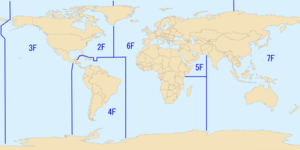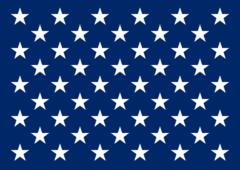United States Navy facts for kids
Quick facts for kids United States Navy |
|
|---|---|
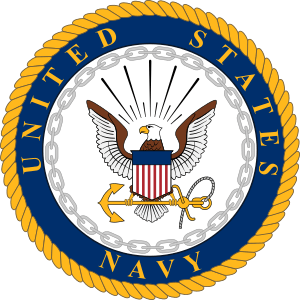
Emblem of the United States Navy
|
|
| Founded | 27 March 1794 (231 years) (in current form) 13 October 1775 |
| Country | |
| Type | Navy |
| Size | 334,896 active duty personnel 54,741 Navy Reserve personnel 387,637 total uniformed personnel (official data as of July 31, 2023) 279,471 civilian employees (As of 2018[update]) 480 ships total, of which 300 are deployable (As of 2019[update]) 2,623 aircraft (As of 2018[update]) |
| Part of | United States Armed Forces Department of the Navy |
| Headquarters | The Pentagon Arlington County, Virginia, U.S. |
| Motto(s) | Semper Fortis ('Always Courageous'), (unofficial). Non sibi sed patriae ('Not for self but for country') (unofficial) |
| Colors | Blue and gold |
| March | "Anchors Aweigh" |
| Anniversaries | 13 October |
| Equipment | List of equipment of the United States Navy |
| Engagements |
See list
American Revolutionary War
Quasi-War First Barbary War War of 1812 Second Barbary War West Indies Anti-Piracy Operations Seminole Wars African Anti-Slavery Operations Aegean Sea Anti-Piracy Operations First Sumatran expedition United States exploration expedition Patriot War Second Sumatran expedition Ivory Coast Expedition Capture of Monterey Mexican–American War Bombardment of Greytown Battle of Ty-ho Bay First Fiji Expedition Filibuster War Second Opium War Second Fiji Expedition Reform War Paraguay expedition American Civil War Bombardment of Qui Nhon Shimonoseki Campaign Formosa Expedition United States expedition to Korea Egyptian Expedition (1882) Bering Sea Anti-Poaching Operations Kingdom of Hawaii overthrowal Second Samoan Civil War Banana Wars
Philippine–American War
1989 air battle near Tobruk
Operation Burnt Frost Operation Ocean Shield Operation Odyssey Dawn 2014 Intervention against ISIL Operation Inherent Resolve War in Afghanistan (2015–2021) 2017 Shayrat missile strike Operation Prosperity Guardian 2024 missile strikes in Yemen |
| Commanders | |
| Commander-in-Chief | |
| Secretary of Defense | |
| Secretary of the Navy | |
| Chief of Naval Operations | |
| Vice Chief of Naval Operations | |
| Master Chief Petty Officer of the Navy | |
| Insignia | |
| Flag |  |
| Ensign |  |
| Jack |  |
| Pennant | |
| Logo |  |
The United States Navy (USN) is one of the world's largest and most powerful navies. It's a crucial part of the United States military, responsible for protecting America's interests around the globe.
It is the world's most powerful navy and the largest by displacement, at 4.5 million tons in 2021. It has the world's largest aircraft carrier fleet. Aircraft carriers have the ability to house 5,000 people. This is the size of a small town floating in the ocean.
The U.S. Navy is the third largest of the United States military service branches in terms of personnel.
As of 2018[update], the navy operates over 460 ships (including vessels operated by the Military Sealift Command), 3,650+ aircraft, 50,000 non-combat vehicles and owns 75,200 buildings on 3,300,000 acres (13,000 km2).
Contents
History
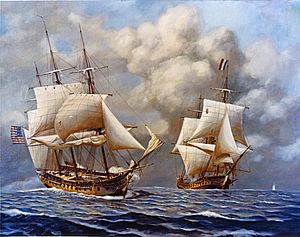
Created in 1775 with the immediate concern of the American Revolution, the U.S. Navy were disbanded in 1783 and the privateers went back to the merchant trade. The needs of international commerce, however, soon drove the requirement for a standing navy, more than it did an army.
The War Department was created in 1789 and handled naval affairs. The Federalist Party, especially under John Adams favored the Navy and created the cabinet-level Department of the Navy in 1798. The Marines originated in 1775, when two battalions of men were raised for continental service; it was deactivated in 1783. The Marine Corps was reactivated by Congress on July 11, 1798, within the new Navy Department. Benjamin Stoddert was the first secretary and directed operations during the "Quasi-War", the undeclared naval war with France (1798-1800).
The Algerian War (1815), suppression of West Indian pirates (1816-29), and antislavery patrols (1820-50) provided training for the Mexican-American War of 1846-48.
In 1815 the Board of Navy Commissioners, consisting of three senior officers, was created to provide technical advice to the department regarding naval technology, naval operations being excluded from its purview. In 1842 an organization of technical bureaus was instituted, including bureaus for the Navy Yards and Docks; Construction, Equipment, and Repairs; Provisions and Clothing; Ordnance and Hydrography; and Medicine and Surgery.
The Navy professionalized the officer corps, with the Naval Academy (1854). It experimented with steam propulsion and sponsored overseas explorations, notably the Pacific expedition (1838-1842) of Lieutenant Charles Wilkes.
The United States Navy played the central role in the World War II defeat of Imperial Japan. The United States Navy emerged from World War II as the most powerful navy in the world. The modern United States Navy maintains a sizable global presence, deploying in strength in such areas as the Western Pacific, the Mediterranean, and the Indian Ocean.
Missions
Its combat functions include anti-surface warfare (ASuW) against ships, anti-submarine warfare (ASW), anti-air warfare (AAW), land attack, littoral warfare, naval gunfire support, mine warfare, amphibious warfare, and Naval Special Warfare.
Key components
Key components of the modern United States Navy are:
- Aircraft carriers: These massive ships are mobile airbases, capable of launching and recovering aircraft for various missions. The Nimitz-class and Gerald R. Ford-class carriers are among the largest and most powerful warships in the world.
- Submarines: These stealthy vessels play a crucial role in reconnaissance, anti-submarine warfare, and strategic deterrence. Nuclear-powered submarines can remain submerged for extended periods.
- Destroyers and cruisers: These ships provide anti-air, anti-submarine, and anti-surface warfare capabilities, acting as escorts for aircraft carriers and other vessels.
- Amphibious assault Ships: These ships carry Marines and their equipment, enabling rapid deployment of forces ashore.
Organization
The United States Navy is part of the Department of the Navy, alongside the United States Marine Corps, which is its coequal sister service. The Department of the Navy is headed by the civilian secretary of the Navy. The Department of the Navy is itself a military department of the Department of Defense, which is headed by the secretary of defense. The chief of naval operations (CNO) is the most senior Navy officer serving in the Department of the Navy.
Operating forces
There are nine components in the operating forces of the U.S. Navy: the United States Fleet Forces Command (formerly United States Atlantic Fleet), United States Pacific Fleet, United States Naval Forces Central Command, United States Naval Forces Europe, Naval Network Warfare Command, Navy Reserve, United States Naval Special Warfare Command, and Operational Test and Evaluation Force. Fleet Forces Command controls a number of unique capabilities, including Military Sealift Command, Naval Expeditionary Combat Command, and Naval Information Forces.
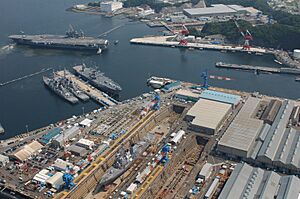
Personnel
The United States Navy has over 400,000 personnel, approximately a quarter of whom are in ready reserve. Of those on active duty, more than eighty percent are enlisted sailors and around fifteen percent are commissioned officers; the rest are midshipmen of the United States Naval Academy and midshipmen of the Naval Reserve Officer Training Corps at over 180 universities around the country and officer candidates at the Navy's Officer Candidate School.
Enlisted sailors complete basic military training at boot camp and then are sent to complete training for their individual careers.
Sailors prove they have mastered skills and deserve responsibilities by completing Personnel Qualification Standards (PQS) tasks and examinations. Among the most important is the "warfare qualification", which denotes a journeyman level of capability in Surface Warfare, Aviation Warfare, Information Dominance Warfare, Naval Aircrew, Special Warfare, Seabee Warfare, Submarine Warfare or Expeditionary Warfare. Many qualifications are denoted on a sailor's uniform with U.S. Navy badges and insignia.
Uniforms
The uniforms of the U.S. Navy have evolved gradually since the first uniform regulations for officers were issued in 1802 on the formation of the Navy Department. The predominant colors of U.S. Navy uniforms are navy blue and white. U.S. Navy uniforms were based on Royal Navy uniforms of the time and have tended to follow that template.
Navy officers serve either as a line officer or as a staff corps officer. Line officers wear an embroidered gold star above their rank of the naval service dress uniform while staff corps officers and commissioned warrant officers wear unique designator insignias that denotes their occupational specialty.
| Type | Line officer | Medical Corps | Dental Corps | Nurse Corps | Medical Service Corps | Judge Advocate General's Corps |
|---|---|---|---|---|---|---|
| Insignia |  |
 |
||||
| Designator1 | 1XXX | 210X | 220X | 290X | 230X | 250X |
| Chaplain Corps (Christian Faith) |
Chaplain Corps (Jewish Faith) |
Chaplain Corps (Muslim Faith) |
Chaplain Corps (Buddhist Faith) |
Supply Corps | Civil Engineer Corps | Law Community (Limited Duty Officer) |
 |
 |
|||||
| 410X | 410X | 410X | 410X | 310X | 510X | 655X |
Insignia and badges of the United States Navy are military "badges" issued by the Department of the Navy to naval service members who achieve certain qualifications and accomplishments while serving on both active and reserve duty in the United States Navy. Most naval aviation insignia are also permitted for wear on uniforms of the United States Marine Corps.
Below are just a few of the many badges maintained by the Navy.
Weapons
Current U.S. Navy shipboard weapons systems are almost entirely focused on missiles, both as a weapon and as a threat. In addition to missiles, the navy employs Mark 46, Mark 48, and Mark 50 torpedoes and various types of naval mines.
Nuclear weapons in the U.S. Navy arsenal are deployed through ballistic missile submarines and aircraft.
The current naval jack of the United States is the Union Jack, a small blue flag emblazoned with the stars of the 50 states.
Notable sailors
Many past and present United States historical figures have served in the U.S. Navy.
Officers
Notable officers include:
- John P. Jones
- John Barry (Continental Navy officer and first flag officer of the United States Navy),
- Edward Preble
- James Lawrence (whose last words "don't give up the ship" are memorialized in Bancroft Hall at the United States Naval Academy)
- Stephen Decatur Jr., David Farragut, David D. Porter, Oliver H. Perry,
- Commodore Matthew C. Perry (who, under the direction of President Millard Fillmore, forced the opening of Japan
- George Dewey (the only person in U.S. history to have attained the rank of Admiral of the Navy
- William D. Leahy
- Ernest J. King
- Chester W. Nimitz
- William F. Halsey Jr.
Presidents
The first American President who served in the U.S. Navy was John F. Kennedy (who commanded the famous PT-109 in World War II); he was then followed by Lyndon B. Johnson, Richard Nixon, Gerald Ford, Jimmy Carter, and George H. W. Bush.
Government officials
Some notable former members of the Navy include U.S. Senators, Bob Kerrey, John McCain, and John Kerry, along with Ron DeSantis, Governor of Florida, and Jesse Ventura, Governor of Minnesota.
Others
Notable former members of the U.S. Navy include; astronauts (Alan B. Shepard, Walter M. Schirra, Neil Armstrong, John Young, Michael J. Smith, Scott Kelly), entertainers (Johnny Carson, Mike Douglas, Paul Newman, Robert Stack, Humphrey Bogart, Tony Curtis, Jack Lemmon, Jack Benny, Don Rickles, Ernest Borgnine, Harry Belafonte, Henry Fonda, Fred Gwynne), authors (Robert Heinlein, Marcus Luttrell, Thomas Pynchon, Brandon Webb), musicians, (John Philip Sousa, MC Hammer, John Coltrane, Zach Bryan, Fred Durst), professional athletes (David Robinson, Bill Sharman, Roger Staubach, Joe Bellino, Bob Kuberski, Nile Kinnick, Bob Feller, Yogi Berra, Larry Doby, Stan Musial, Pee Wee Reese, Phil Rizzuto, Jack Taylor), business people (John S. Barry, Jack C. Taylor, Paul A. Sperry), and computer scientists (Grace Hopper).
Images for kids
-
USS Constitution vs HMS Guerriere during the War of 1812
-
A carte de visite of a U.S. Navy lieutenant during the Civil War
-
Navy SEALs at one of the entrances to the Zhawar Kili cave complex
-
USS Port Royal, a Ticonderoga-class cruiser
-
USS Jack H. Lucas, a Arleigh Burke-class destroyer
-
USS Constitution, firing a 17-gun salute in 2014
See also
 In Spanish: Armada de los Estados Unidos para niños
In Spanish: Armada de los Estados Unidos para niños


